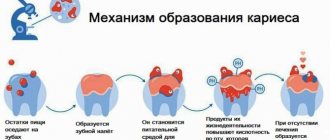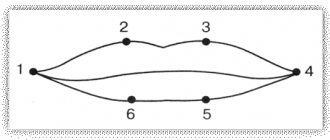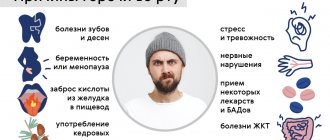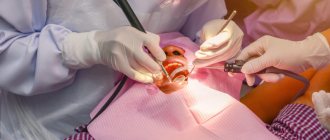Treatment of gums in children is a common reason for visiting a dentist. The susceptibility of delicate gums to inflammatory processes is explained by their sensitivity to all kinds of damage and poor hygiene. The remaining soft plaque on the teeth eventually turns into hard deposits in the form of tartar. Inflammation can also be caused by an infection that enters the oral cavity through dirty toys, for example. Unfortunately, parents are not always able to monitor the regularity and quality of brushing their children’s teeth or protect them from licking dirty surfaces.
Inflammation of the mucous membrane of the gums or gingivitis must be detected as early as possible and treatment begun. This is why regular scheduled examinations are so important. A delay in making a visit can result in a complication - there is a risk of transition to a chronic form, after which - to the ulcerative-necrotic stage, and, as a result, damage to surrounding tissues. Periodontitis is one of the most serious stages of gum disease.
Teething in infants is not only a painful process, but also provokes inflammation of the gums, as well as injuries, as a result of diligently sucking a rattle or a cracker offered by the mother...
Causes of gum inflammation in children
- Skipping or poor quality teeth brushing;
- Sucking dirty objects;
- Errors when installing seals;
- Pathologies of the dentition;
- Carious cavities with sharp edges;
- Bite correction;
- Breathing through the mouth;
- Abnormal structure of the oral cavity organs (attachment of the frenulum of the tongue and lips);
- Problems with the functioning of the cardiovascular system;
- Disruption of the gastrointestinal tract;
- Infectious diseases (ARVI, influenza);
- Hormonal abnormalities;
- Hereditary anomalies.
Prevention
The main means of preventing gingivitis, as well as other dental diseases, is oral hygiene. From a very early age, teach your child to brush their teeth for at least 10-15 minutes, making sure to pay attention to the inside of the teeth. Buy your child a therapeutic toothpaste and make sure he brushes his teeth correctly. To eliminate stubborn plaque, you can use a brush with moderately hard bristles. After brushing, teeth should be rinsed thoroughly.
Teach your child to use dental floss to remove food debris from between the teeth. But keep in mind that dental floss can also injure the gums if used incorrectly, so it is not recommended to use dental floss for a child under 3 years of age.
Modern dentistry does not encourage the use of toothpicks for dental care, since their use risks not only injuring the gums, but also causing infection. Give preference to dental floss.
If tartar has formed in your child’s mouth, then a visit to the dentist is essential. The doctor will remove tartar in the most gentle way possible.
Types of inflammatory processes
Gingivitis
Inflammation of the gums at the initial stage, that is, not yet spreading to the bone tissue, is called gingivitis.
Treatment of gingivitis in children follows the same principle as in adults, with the only difference being that children are prescribed more gentle medications. When starting the procedure, the hygienist performs professional cleaning, removing plaque and stone, after which he teaches the little patient proper hygiene techniques. Helps you navigate the selection of toothpaste and brush.
Periodontitis
Inflammation of the gums and periodontal tissues - periodontitis - is an advanced stage of gum disease. If left untreated, its progression may result in one or more teeth having to be removed.
Treatment includes occupational hygiene and physical therapy. If the process is advanced, surgical intervention may be required.
Periodontal disease in children
The defeat of all periodontal tissues, in this case, is called childhood periodontal disease. This degree is quite rare. Progression can be triggered by weakened immunity and vitamin deficiency.
An effective option in this case is surgical intervention, as well as strengthening the general condition of the body.
Stomatitis in children
Infectious inflammation of the mucous membrane of the gums, or stomatitis, is characterized by increased sensitivity and discomfort while eating. Therefore, you should show it to a dentist as soon as possible. A dental clinic specialist will examine the baby and prescribe appropriate procedures.
Gingivitis in children: what are the causes and symptoms
Gingivitis, or inflammation of the mucous membrane around the teeth in children, is a fairly common phenomenon. Most often, gingivitis can be detected in a child aged 1–3 years, as well as in adolescence - in both cases, the “trigger” of the disease can be active growth of the body, hormonal changes and features of the formation of the immune system
Gingivitis in children develops quite quickly. If inflammation develops in a child’s mouth, the number of bacteria increases significantly compared to the norm. Within 72 hours, the process of stone formation from soft plaque begins, and the first signs of gum erosion appear. If the situation is neglected, this can lead to the loss of teeth in children - both milk and permanent.
Symptoms of gingivitis in children
How does gingivitis manifest itself in children? The symptoms are:
- bad breath
- discomfort, pain in the mouth
- bleeding gums
At the same time, the temperature with gingivitis in children does not always rise. Therefore, it is quite easy to miss the onset of the disease. A child may tolerate discomfort without attaching any importance to it, or endure it, fearing a visit to the dentist (especially if he has already had a bad experience with dental treatment). That is why it is necessary to unobtrusively check the oral health of your son or daughter from time to time. For kids this can be done during play, but for a teenager you will have to find a psychological approach. Perhaps it would be easier (and more correct!) to “introduce” your offspring to a professional dentist whom he can trust, and periodically take him for preventive examinations.
Types of gingivitis in children
Only a competent doctor can determine what form of gingivitis a child is suffering from and, accordingly, prescribe effective treatment that quickly relieves discomfort. The disease can manifest itself in different ways:
- Catarrhal gingivitis. Children aged 3–7 years are most often affected. It is accompanied by swelling of the tissues around the tooth, unpleasant taste in the mouth, pain when pressure is applied to the gums, the appearance of pink saliva, general malaise and tearfulness. This type of disease easily becomes chronic, when gingivitis occurs approximately twice a year, causes temporary inconvenience to the child and seems to go away on its own. In fact, each time the inflammatory process becomes more and more severe, hard dental deposits are formed, which can ultimately “develop” into periodontitis - a disease in which the bonds of the tooth with the surrounding tissues are destroyed, which leads to its loss.
- Hypertrophic gingivitis. Painful sensations in a child do not appear immediately. The area of the front teeth is most often affected - the gums swell, changing their color (up to purple-blue). Over time, the tissues grow, covering a significant part of the tooth area, gum pockets appear, pus begins to be released, and severe pain appears.
- Atrophic ginivitis. This form of gingivitis is characterized by “recession” of the gums: the neck (and sometimes even the root) of the tooth is exposed, the child feels discomfort from eating cold and hot food. In this case, the gums become pale and bleed slightly. This is not only unpleasant and unsightly, but also quite dangerous and difficult to treat: you will most likely have to restore the shape of the gums using mini-plastic surgery.
- Ulcerative gingivitis. This is one of the options for the development of catarrhal gingivitis: the inflammatory process does not become chronic, but intensifies. Bleeding ulcers appear in the child's mouth, covered with a gray film - this is dead gum tissue. The child cannot eat and sleep normally, experiences severe pain, his body temperature rises to 39 °C... This development of the disease can be avoided by consulting a doctor at the first signs of gingivitis in the child.
Causes of gingivitis in children
Of course, parents want to believe that they will not have to treat gingivitis in children, knowing the causes of its occurrence. It’s really important to know them - they can be:
- Systemic diseases of the body (failure of the endocrine, cardiovascular, digestive, hormonal systems, the influence of infection)
- Dental pathologies, bite defects and errors in their correction
- Incorrect installation of fillings or their deformation
- Advanced caries, careless attitude of parents towards the health of the child’s teeth
- Weakened immunity, lack of vitamin C, poor appetite
But the main and main reason for the development of gingivitis in both children and adults still remains poor oral hygiene. Remember this the next time you allow your baby to “so be it, don’t brush his teeth just once”!
Expert opinion
There are many reasons for the development of gingivitis in a child, and not all of them are directly related to the condition of the oral cavity.
However, treatment should begin with a visit to the dentist: he will determine the form of the disease and prescribe the correct treatment, which will effectively relieve the symptoms - that is, quickly improve the child’s well-being. After all, sometimes inflammation of the gums causes real suffering to the baby, and he cannot even explain what is bothering him! A professional dentist will immediately understand what’s going on when he sees the clinical picture of the disease, and will definitely find an approach to the most capricious young patient. After this, parents (who will also immediately feel better after their child stops experiencing pain) should fully examine the child, starting with a clinical blood test.
Perhaps the inflammation is associated with teething, the formation of roots and the formation of a bite - this is the best option, it can be conditionally classified as normal. Otherwise, you will need to consult specialists from other medical specialties - you will need to look for and treat the cause of gingivitis.
Gum atrophy
A rather unique and rare disease - gum atrophy or exposing atrophic gingivitis manifests itself as itching in the area of 2, less often 4 and 6 symmetrically located milk teeth. A child experiencing discomfort constantly rubs the area of inflammation. At night, the itching usually intensifies.
The interdental papillae and other areas of the gums do not change in any way during gingival atrophy. Slight deposits of tartar are often observed on the unprotected root surface.
The manifestation of itching can be a consequence of measles or influenza, despite the fact that in most young patients such a relationship is not observed. The process of teething is also one of the factors causing itching in infants.
Diagnosis of gum disease in children
A routine oral examination should be performed by a pediatric dentist every six months. And as necessary, if a small patient exhibits any deviations in the development of teeth or symptoms of disease of the oral mucosa. Since it is advisable to diagnose the inflammatory process at the earliest stage.
If redness, swelling and bleeding are detected, the cause of which is an excessive amount of soft plaque or food debris on the teeth, the dentist will make a diagnosis and prescribe procedures.
If a bacterial infection is suspected, a clinic specialist can take biomaterial from the inflamed areas of the gums for clinical tests. Based on the results of the analysis, the specialist prescribes a treatment plan and the date of the next appointment to ensure the final recovery of the little patient.
Cyst treatment
A dental cyst is treated either with therapeutic methods or with surgical intervention. The first ones are used in simple cases.
Surgery involves two types of operations - cystotomy and cystectomy. In both cases, local anesthesia is used. With cystomy, only the anterior wall of the cyst is removed. This is a less traumatic option, as it allows you to preserve the rudiments of permanent teeth during surgery on milk teeth.
Cystectomy is performed if the size of the cyst does not exceed 1.5 cm. This operation is more difficult, but postoperative recovery is much faster.
No matter how small and insignificant the swelling may seem to you, contact your dentist. This will avoid complications. And the problem will be resolved more easily and in a short time. Remember that no rinses, infusions or other folk remedies can guarantee recovery.
Treatment of gums in children
Medicines prescribed by a doctor have analgesic, antibacterial and anti-inflammatory effects. They help restore the proper condition of the mucous membrane. Methods of using drugs are different, but the principle is the same: rinsing, irrigation.
For gum disease in infants, the dentist will prescribe special gels to relieve symptoms, namely itching and pain. Parents should pay special attention to cleaning their mouths from food debris.
Antibiotics are prescribed by a dentist in rare cases. Indications for the use of antibiotics is a form that reaches a complex (ulcerative-necrotizing gingivitis) or chronic stage. Antibacterial or antifungal drugs are prescribed when the problem is caused by an infectious process, and the goal is to eliminate its causative agent.
Causes of Teething Cysts in Children
During teething, a hematoma is formed; it occurs due to the fact that the tooth cannot break through the mucous membrane and thereby injures the gums and ruptures blood vessels. The longer the formation is in the oral cavity, the larger its size; in addition, the amount of swelling will depend on the group affiliation of the tooth.
The main causes of the tumor:
- pulpitis;
- caries;
- periodontitis;
- improper tooth treatment or lack thereof;
- eruption injuries.
The baby’s body tries to limit the source of infection, which is why a dense protective capsule is formed, which eventually develops into a cyst. The occurrence of such formations is quite common. An infection caused by carelessness, an unsuccessful attempt to chew hard food, a fall that led to a tooth injury - all this can serve as a starting point for gum inflammation and further development of a cyst.
Another fairly common mistake parents make, which can lead to the appearance of a tumor during teething, is negligence in caring for baby teeth.
It is generally believed that you should take serious care of your dental health after changing them. Since there is no point in treating non-permanent baby teeth - they will soon fall out. In fact, not taking things seriously leads to many problems. Any gum diseases and oral infections should be eliminated in a timely manner, regardless of how many teeth the baby has and whether they are permanent or not.
Preventive actions
The best prevention of inflammation of the mucous membrane is daily and high-quality hygiene from an early age and proper nutrition.
Hygiene
The concept of “quality hygiene” includes brushing your teeth at least twice: in the morning and in the evening, in conjunction with cleaning the palate and tongue.
Parents should take a very responsible approach to hygiene from the day the first tooth appears. And after he grows up a little, learn the rules of brushing his teeth: regularly and efficiently. The toothbrush and toothpaste should be selected according to the age of the small patient.
Nutrition
In addition to hygiene, parents need to approach the diet wisely: it should be balanced and include vitamins and minerals. Sweets and carbonated drinks should be consumed by the child in limited quantities. In addition, after finishing eating sweets, the baby should rinse his mouth with water and, if possible, brush his teeth. Note that a diet that promotes the proper development of a growing body includes nutritious and timely meals. Snacking and disordered eating should be kept to a minimum.
What to do if you suspect gingivitis?
If, during examination of the oral cavity, you find redness and swelling of the gums, you should:
- make an appointment for your child with the dentist in the near future;
- if the baby has a fever, give him an antipyretic drug in accordance with his age;
- if you complain of pain, treat the gums with a 0.25% solution of potassium permanganate, a 3% solution of hydrogen peroxide in the form of irrigation or rinsing. These are temporary measures, they are not a treatment for gingivitis, but will simply relieve swelling and pain a little;
- take your child to the dentist.
Remember that oral hygiene and a healthy lifestyle are the key to strong teeth and healthy gums for your child!
Treatment of children at RAIDEN
In the RAIDEN network of dental clinics, the treatment and prevention of oral diseases of young patients is treated with the utmost attention and reverence - the health of the younger generation is very important to us!
All medications used in our clinic meet the highest quality requirements. Before using them, we conduct a blood test of the baby to determine drug tolerance. The safety of your children, our little patients, is paramount to us.
Peculiarities
Gingivitis is extremely common in childhood and adolescence, as children are most susceptible to gingivitis. This is due to the increased susceptibility of periodontal disease in children.
The periodontium is a “structure” of various tissues that holds the tooth and also supplies it with necessary substances through an extensive network of blood vessels.
The incidence of gingivitis reaches its peak with the onset of middle school age, when the accelerated growth of periodontal tissue is superimposed on the “hormonal explosion” characteristic of adolescents.
Gingivitis is not uncommon in very young children, 1 year of age or younger. This is understandable, because one of the main factors in the occurrence of gingivitis is gum trauma, which is what happens during teething. And to these natural injuries is added the underdevelopment of the immune system and the weak saturation of the oral cavity of a small child with beneficial microflora.
Sometimes you can find gingivitis even in infants. Parents are advised to immediately contact a pediatric dentist if they detect any suspicious symptoms at such a tender age.
An additional risk factor may be a short frenulum of the lip, which interferes with proper gum hygiene and contributes to the accumulation of food debris. In most cases, the labial frenulum stretches on its own, but if this does not happen before the child is 2 years old, surgical resection is performed as prescribed by the doctor.











